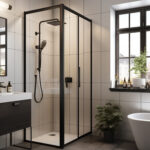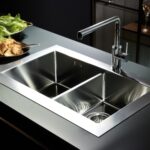Kitchen revolves around the sink. Choosing a sink that best matches your needs and lifestyle is a critical factor in have a truly functional and efficient kitchen. Here are the key points you need to consider when choosing a new kitchen sink…
- Size
In additional to making sure that the size of the individual bowls meet your needs, also consider the overall size of the sink. A larger sink provide more space for washing dishes but also takes away counter space which is especially critical in smaller kitchens. Also make sure your new sink will fit the existing cabinets. Some larger sinks might require custom sized cabinets.
- Number of Bowls
How do you use your kitchen sink? Do you wash a lot of baking pans? If so, consider a large single bowl sink or a dual level sink with enough room to lay the pans down to soak. Most dual level sinks feature an oversized bowl to wash or soak things, with another smaller sink for rinsing or a garbage disposal. Make sure both bowls are large enough to meet your kitchen needs. If you share kitchen responsibilities, consider two sinks. One can be used for food prep and the other for clean-up. An island or bar sink, usually a smaller single bowl sink, is the best option.
- Features you really need
-Steep, straight side walls
Deeper bowls can accommodate soaking and rinsing large pots and pans. A relatively flat sink bottom increases usable bowl space and allows dishes and glasses to be safely stacked.
-Off-set Drains
Placing the drain to one side provides more flat space for stacking dishes and glasses and creates more usable space under the sink. Offset drains also allow water to drain, even if a large pan or tray is soaking in the sink.
-Web/Divider
For double bowl sinks, make sure the web divider between the two bowls is lower than the outside sink walls. This will provide overflow protection by allowing water to flow from one bowl to the other.
- Countertop or undercounter
– Undercounter mount sinks mount directly to the underside of countertop material. This installation provides a flush mounting making it easy to clean. When choosing an undermount sink consider what type of countertop you have make sure the edges around the sink opening can be finished.
–Self-rimming sinks have rounded corners and mount on the surface of the countertop material. This is the easiest type of installation, requiring only adhesive caulk to seal the sink in place.
- Faucet Type
The faucet you choose will dictate the number of holes you need in your sink. Choose your ideal faucet and then order the sink accordingly. Also consider additional holes for accessories such as soap dispensers and pull out hand sprays.








